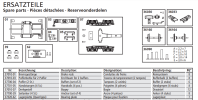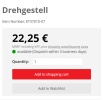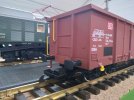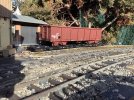idlemarvel
Neither idle nor a marvel
This is one of the first PIKO wagons to be produced, in 2008. Since then many versions of the Eaos gondola have been produced, at least 16, in a multitude of colours from brown to green, blue, yellow, even pink and magenta.
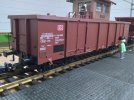
The prototype was and in some variants still is used on many European railways, including Germany, Austria, and Switzerland. The version in this model is Eaos 106 (without handbrake) which was the first version of this wagon, and is in DB livery. They were in use from 1978 until 2018. The steel walls in the early version were found to be too thin as you can see from this picture of an Austrian wagon:

The model is quite a good likeness (without the dents!). The number of panels and reinforcement bars is correct, apart from the horizontal bars on the front panel, but I think they varied as operators tried to reinforce the original steel panels. The bogies are not a bad representation either:
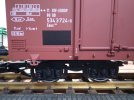
Details of the prototype can be found here:

 de.wikipedia.org
There is more information here but it is a "non-secure" site (because it doesn't use HTTPS).
de.wikipedia.org
There is more information here but it is a "non-secure" site (because it doesn't use HTTPS).
 www.dybas.de
www.dybas.de
The prototype and model dimensions are as follows:
length 14.04 m 520 mm scale 1:27
height 2.02 m 119 mm scale 1:27
width 2.76 m 110 mm scale 1:25
wheelbase 1.80 m 66 mm scale 1:27
pivot 9.00 m 334 mm scale 1:27
So it is all pretty much in scale. PIKO models use a rubber ruler like LGB and are generally in scale within the range of 1:26-1:29. As they are meant to represent standard gauge models they should be 1:32 (gauge 1) but they are made a little larger so they can be mixed with LGB stock which is typically narrow gauge.
The UIC numbering on the model is accurate for Eaos wagons and goes like this:
11 11 means this is a 4-axle freight wagon
80 80 is country code for Germany
534 50x-55x means open wagon and 534 is one of the codes within that range for Eaos wagons
3 724-0 serial number with checksum
For more details of UIC numbering see here:
UIC-Wagennummer – Wikipedia (German)
or here:
Railfaneurope.net (English but again "non-secure" site)
I have fitted (LGB) metal wheels (30 mm). The coupling hooks are standard loop and hook and are at the correct height above rail. It runs fine on R1 curves and points despite the length. Without metal wheels it would be a bit light and you might get some "stringing" derailments if you ran a long rake around R1 curves. Unlike similar LGB models the doors do not open but I've never found a lot of use for that kind of thing. The model comes with alternative central "narrow gauge" buffer beams which might be useful if you wanted to run this on an RhB themed layout for example.
Overall this is a good, realistic and reasonably detailed model and they can be found quite cheaply second hand, £50-60. New ones are £160 RRP and if you add metal wheels you are getting to £200 which is probably a bit much for me, but each to their own.
I don't intend to do much detailing other than to paint the grabrails and loading hooks yellow, and the buffer beams should be brown not black. I'll update the thread when I've done that.

The prototype was and in some variants still is used on many European railways, including Germany, Austria, and Switzerland. The version in this model is Eaos 106 (without handbrake) which was the first version of this wagon, and is in DB livery. They were in use from 1978 until 2018. The steel walls in the early version were found to be too thin as you can see from this picture of an Austrian wagon:

The model is quite a good likeness (without the dents!). The number of panels and reinforcement bars is correct, apart from the horizontal bars on the front panel, but I think they varied as operators tried to reinforce the original steel panels. The bogies are not a bad representation either:

Details of the prototype can be found here:

Eaos – Wikipedia
dybas - Güterwagen DB AG - E
The prototype and model dimensions are as follows:
length 14.04 m 520 mm scale 1:27
height 2.02 m 119 mm scale 1:27
width 2.76 m 110 mm scale 1:25
wheelbase 1.80 m 66 mm scale 1:27
pivot 9.00 m 334 mm scale 1:27
So it is all pretty much in scale. PIKO models use a rubber ruler like LGB and are generally in scale within the range of 1:26-1:29. As they are meant to represent standard gauge models they should be 1:32 (gauge 1) but they are made a little larger so they can be mixed with LGB stock which is typically narrow gauge.
The UIC numbering on the model is accurate for Eaos wagons and goes like this:
11 11 means this is a 4-axle freight wagon
80 80 is country code for Germany
534 50x-55x means open wagon and 534 is one of the codes within that range for Eaos wagons
3 724-0 serial number with checksum
For more details of UIC numbering see here:
UIC-Wagennummer – Wikipedia (German)
or here:
Railfaneurope.net (English but again "non-secure" site)
I have fitted (LGB) metal wheels (30 mm). The coupling hooks are standard loop and hook and are at the correct height above rail. It runs fine on R1 curves and points despite the length. Without metal wheels it would be a bit light and you might get some "stringing" derailments if you ran a long rake around R1 curves. Unlike similar LGB models the doors do not open but I've never found a lot of use for that kind of thing. The model comes with alternative central "narrow gauge" buffer beams which might be useful if you wanted to run this on an RhB themed layout for example.
Overall this is a good, realistic and reasonably detailed model and they can be found quite cheaply second hand, £50-60. New ones are £160 RRP and if you add metal wheels you are getting to £200 which is probably a bit much for me, but each to their own.
I don't intend to do much detailing other than to paint the grabrails and loading hooks yellow, and the buffer beams should be brown not black. I'll update the thread when I've done that.

